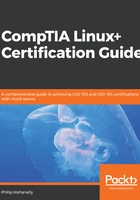
Summary
In this chapter, we focused on the various methods for package management. First, we delved into the traditional way of package management; that is, to use the dpkg utility. We looked at ways to view the current packages on the system. We also touched on querying for a particular package. Then we looked at the various locations in which a package would install files. Adding to that, we did an actual installation of a package. We then verified that the package was indeed installed. This was followed up by the removal of a package. Next, we switched our attention to a more common approach to package management; namely, APT. We used best practice, which is to always pass the update option with apt. We then focused on the method of searching for a package. Adding to this, we looked at the current packages. We also focused on getting some useful information on a particular package.
This was followed up by the installation of a package. At this point, we saw that we can install multiple packages on a single apt-get command. This was followed by a demo on updating the packages. In addition to this, we looked at how to remove a package using the apt-get command. Finally, we worked with aptitude. On its own, the aptitude command presents a user-interactive, menu-driven environment. We also looked at passing options with the aptitude command. Initially, we updated the package list. This was followed by an upgrade of the packages. Adding to this, we saw the technique for searching for packages. Then a package installation was performed using the command line. Following this, we did a demo on removing a package at the command line. Finally, we ended with an alternative to the command line: the synaptic utility. The synaptic utility, which is based on APT, is a GUI for package management.
In the next chapter, we take a deep dive into the world of Red Hat package management; particularly Fedora. There, we will cover the various techniques we would use to manage packages, such as rpm, yum, dnf, and yumex. I hope you come and join in, because I'm confident you will become better equipped to managing packages in the Red Hat world after going through the next chapter. This will ultimately take you one step closer to certification.